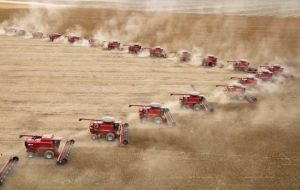MercoPress. South Atlantic News Agency
Is Brazil the reservoir of future agriculture productive capacity?
 The soybean area in Brazil is forecast to expand for the fifth year running to 67/69 million acres, according to forecasts
The soybean area in Brazil is forecast to expand for the fifth year running to 67/69 million acres, according to forecasts The following piece was published by Dorvers, CattleNnetwork and refers to the agriculture potential of Latinamerica and Mercosur largest economy. The column sources are Daryll E. Ray and Harwood D. Schaffer, Agricultural Policy Analysis Center, University of Tennessee, Knoxville, TN.
Back in 2001, we estimated that Brazil could bring 200 to 300 million acres of land into agricultural production—an area equal to the US acreage involved in major crop production. Two years later the, USDA Foreign Agricultural Service, (FAS) estimated that over time the potential added production acreage could be closer 420 million acres.
In our 2003 article describing the FAS report we wrote: “The long-term trend suggests that this expansion would proceed at the rate of 3 to 4% a year, if current conditions continue to prevail. Significantly lower crop prices or higher cattle prices could retard the expansion of crop acreage, while high crop prices could accelerate the growth in crop acreage.
“This growth is premised on three conditions: 1) the legalization of the production of GMO crops in Brazil; 2) the widespread adoption of high-yield crop varieties; and 3) improvement in the transportation infrastructure in Brazil that will lower the cost of getting agricultural crops to the port.”
Let’s look at this information once again, nearly a decade later. Crop prices this year are at record levels. Brazil has long since adopted the cultivation of GMOs and soybean yields match or exceed those in the US, depending upon weather. The only obstacle Brazil farmers face is getting the crop from the field to international markets, though that will not always be a problem.
Thus we were not surprised to read, in a series of three DTN articles by Alistair Stewart, that “record prices will prompt Brazilian farmers to plant soybeans on any available ground this season [note the word “season” not “year”], whether it be old pasture in the east of Mato Grosso, recently cleared scrub in the new frontier lands of the northeast, or land previously earmarked for corn in the south. As a result, soybean-planted area is set to rise for a fifth-consecutive year—by 8% to 12% to 67 million to 69 million acres—forecasters say.”
And that is not all, if farmers in a number of areas are able to get the soybeans growing in time, they will be able to double-crop their fields with corn in late February. While corn yields in Brazil are well below those in the US, a second crop of corn helps cover fixed costs, increasing already profitable margins per hectare. Those who are able have every reason to try to double-crop their fields.
Though today’s Brazilian corn yields are nowhere near those in the US that is unlikely to be the case in the long-run. The current high prices will certainly drive investment in the research necessary to increase yields.
In addition to double cropping, Brazilian farmers have the option to rotate crops with cattle production, an option unavailable to most Iowa and Illinois farmers. In 2003 when we talked to a member of the FAS team that estimated the 420 million acres, he told us that the rotation of livestock and crops, particularly soybeans, accounted for a portion of the increased acreage they had identified. That option is particularly attractive given the synergy between crop and livestock production.
In the last decade Brazil has made some progress improving its transportation infrastructure, but with the huge increase in crop production, there is still a long way to go. However, once again today’s high prices are driving long-term investments in paving roads, extending railroads, and improving port facilities all with the goal of reducing transportation costs.
To us all of this suggests that, for the foreseeable future, the world’s ability to grow crops, lead by Brazil, will continue to run ahead of population growth, putting a downward pressure on crop prices. As suggested by the word “continue,” this is indeed what has been happening over the decades, with the major geographical contributions to agricultural productivity varying over time.
However, there are those who believe that agriculture has entered a “new era.” They argue that future agricultural supply and demand conditions will cause inflation-adjusted agricultural prices to reverse their historical patterns and trend upward in the years and decades ahead.
Although such Malthusian predictions are been embarrassingly common, some of the arguments this time around are worth seriously considering. (Drovers, Cattlenetwork).




Top Comments
Disclaimer & comment rules-

-

Read all commentsYeaaah for Brazil and Unasur!
Oct 17th, 2012 - 03:59 pm 0Is this at the expense of the rain forest ?
Oct 17th, 2012 - 04:41 pm 0Commenting for this story is now closed.
If you have a Facebook account, become a fan and comment on our Facebook Page!